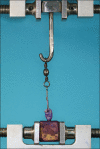Comparison of marginal leakage and retentive strength of implant-supported milled zirconia and cobalt-chromium copings cemented with different temporary cements
- PMID: 38169570
- PMCID: PMC10758385
Comparison of marginal leakage and retentive strength of implant-supported milled zirconia and cobalt-chromium copings cemented with different temporary cements
Abstract
Background: Few studies assessed the effect of coping material (particularly milled metal copings) on the retentive strength of cements and reported contradictory results. Thus, this study aims to assess the marginal leakage and retentive strength of implant-supported milled zirconia and cobalt-chromium (Co-Cr) copings cemented with different temporary cements.
Materials and methods: In this in vitro study, Zirconia and Co-Cr copings were fabricated on 100 straight titanium abutments. Each group of copings was divided into five subgroups (n = 10) for the use of different cements: permanent zinc-phosphate (ZP) cement, temporary zinc oxide eugenol cement (temp bond [TB]), calcium hydroxide-based temporary cement (Dycal [DC]), polymer-based eugenol-free acrylic-urethane temporary cement (Dentotemp [DT]), and methacrylate-based temporary cement (Implantlink [IL]). The retentive strength and marginal leakage of restorations were assessed. Data were analyzed by one-way ANOVA, Tukey, and Fisher's exact tests (α = 0.05).
Results: In the Co-Cr group, the retentive strength values (in Newtons) were as follows: ZP (411.40 ± 5.19) >DC (248.80 ± 5.01) >IL (200.10 ± 5.06) >DT (157.90 ± 5.19) >TB (98.50 ± 6.88). This order was as follows in the zirconia group: ZP (388.70 ± 5.35) >DC (226.60 ± 5.08) >IL (179.00 ± 3.71) >DT (136.00 ± 4.88) >TB (78.60 ± 3.50). All pairwise comparisons were statistically significant (P < 0.001). The difference in marginal leakage was not significant among the groups (P = 0.480).
Conclusion: The type of coping material and cement type significantly affected retentive strength, but not marginal leakage, of implant restorations. Milled Co-Cr copings showed higher retentive strength than zirconia copings, and ZP cement followed by DC yielded the highest retention.
Keywords: Computer-aided design; dental cements; dental prosthesis; implant-supported.
Copyright: © 2023 Dental Research Journal.
Conflict of interest statement
The authors of this manuscript declare that they have no conflicts of interest, real or perceived, financial or non-financial in this article.
Figures



Similar articles
-
Retentive strength of metal copings on prefabricated abutments with five different cements.Clin Implant Dent Relat Res. 2005;7(4):229-34. doi: 10.1111/j.1708-8208.2005.tb00068.x. Clin Implant Dent Relat Res. 2005. PMID: 16336914
-
Cement selection for implant-supported crowns fabricated with different luting space settings.J Prosthodont. 2013 Feb;22(2):112-9. doi: 10.1111/j.1532-849X.2012.00912.x. J Prosthodont. 2013. PMID: 23387964
-
Effect of production method on surface roughness, marginal and internal fit, and retention of cobalt-chromium single crowns.J Prosthet Dent. 2017 Jul;118(1):95-101. doi: 10.1016/j.prosdent.2016.09.025. Epub 2016 Dec 23. J Prosthet Dent. 2017. PMID: 28024818
-
The effect of different methods of cleansing temporary cement (with and without eugenol) on the final bond strength of implant-supported zirconia copings after final cementation: An in vitro study.Dent Res J (Isfahan). 2023 Feb 14;20:22. doi: 10.4103/1735-3327.369624. eCollection 2023. Dent Res J (Isfahan). 2023. PMID: 36960017 Free PMC article.
-
Retention of zirconia copings on zirconia implant abutments cemented with provisional luting agents.J Oral Rehabil. 2010 Jan;37(1):48-53. doi: 10.1111/j.1365-2842.2009.02013.x. Epub 2009 Oct 22. J Oral Rehabil. 2010. PMID: 19849775
Cited by
-
Influence of the Composition of Provisional Luting Materials on the Bond Strength of Temporary Single-Tooth Crowns on Titanium Abutments.Materials (Basel). 2024 Aug 27;17(17):4239. doi: 10.3390/ma17174239. Materials (Basel). 2024. PMID: 39274629 Free PMC article.
-
Effect of screw access hole or vent hole opening strategies on the adhesive filling rate of oral implant cement-retained posterior crowns.PLoS One. 2025 May 15;20(5):e0323092. doi: 10.1371/journal.pone.0323092. eCollection 2025. PLoS One. 2025. PMID: 40373012 Free PMC article.
References
-
- Saleh M, Taşar-Faruk S. Comparing the marginal leakage and retention of implant-supported restorations cemented by four different dental cements. Clin Implant Dent Relat Res. 2019;21:1181–8. - PubMed
-
- Lopes AC, Machado CM, Bonjardim LR, Bergamo ET, Ramalho IS, Witek L, et al. The effect of CAD/CAM crown material and cement type on retention to implant abutments. J Prosthodont. 2019;28:e552–6. - PubMed
LinkOut - more resources
Full Text Sources
